The time of the spark plug firing has much importance as it is associated with the performance of the engine. It is necessary to fire the spark plug at the right time to enhance engine performance for obtaining maximum power output and to avoid the engine knocking.
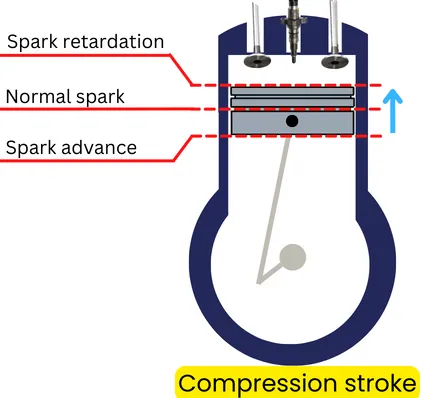
In this article, we will discuss Advancing and retarding ignition timing, their importance as well as their effects on engine performance, etc.
Contents:
What is Spark advance?
Spark advance or ignition time advance is the earlier firing of the spark plug during the compression stroke before the piston reaches the top dead center.
The spark advance helps to achieve maximum peak pressure in the cylinder just after the piston reaches the top dead center.
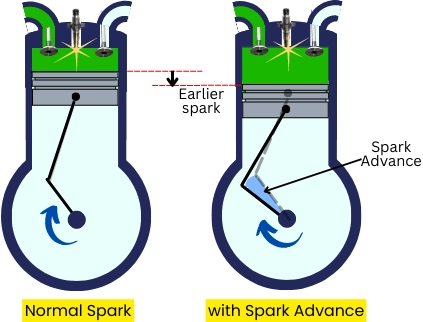
Why is Spark advance required?
When we fire the spark plug into the compressed charge, the ignition nucleus is formed which further creates the first flame into the combustion chamber of the engine. Then this flame propagates into the cylinder to burn the compressed charge and generates high pressure and temperature inside the cylinder.
This process of combustion is not instantaneous. It takes a certain amount of time between generation of a spark and obtaining high pressure.
In the case of a high engine speed, after the completion of the compression stroke, the piston stops at TDC for very less time. So this time is not enough to generate high pressure by firing spark plug.
Therefore by Spark advancing, the spark plug is fired few degrees (crank angle) before the piston reaches TDC. Thus it gets enough time for combustion, flame propagation and generation of peak pressure.
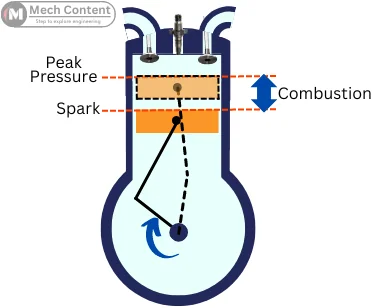
By achieving the maximum peak pressure just after piston reaching TDC, the piston can convert the maximum amount of pressure energy into the power output.
Therefore the spark advance helps to increase the power output and achieve the maximum fuel economy.
The below figure shows the crank angle vs pressure graph for the normal spark and for the effect of spark advance. The graph indicates the pressure variation at high engine speeds.
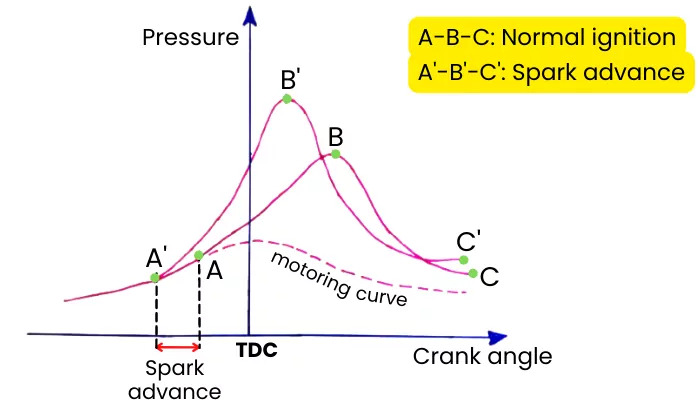
Curve A-B-C shows the pressure rise during normal ignition and curve A’-B’-C’ shows the pressure rise during spark advance.
Thus because of spark advance, the pressure inside the cylinder can reach to maximum peak pressure just after the piston reaches TDC.
Factors affecting the Spark advance:
The amount of spark advance required depends on some of the following important factors:
1] Temperature: As the temperature of charge increases, the time required for the combustion of fuel decreases. Therefore the requirement of spark advancing also decreases with an increase in charge temperature.
2] Charge density: If the density of charge is higher, the molecules of charge are very close to each other. Thus in this condition, the propagation of flame takes place faster. Thus for the higher charge density, the spark advancing requirement is lower.
3] Quality of charge: Due to improper scavenging in an engine, some parts of the exhaust gases get mixed with the fresh incoming charge. Due to the contamination of the fresh charge, the speed of the flame propagation is slower. Thus in this condition, the engine requires more spark advance.
Effects of Advanced ignition timing:
The advancing of the ignition timing affects the Internal combustion (IC) engine performance as described below:
Because of the spark advance, the combustion of the fuel completes earlier. So the hot combustion products can attain maximum pressure just after the piston reaches to the TDC.
Therefore the mean effective pressure (Pₘ) of an engine increases which leads to the maximum power output.
Ignition timing too advanced symptoms:
Here are the symptoms of too much advanced ignition timing.
1] Pinging Noice:
If the ignition time is set too advanced then the charge gets combusted too early during the compression stroke.
It results in the peak pressure achieved inside the engine during the compression stroke. This peak pressure opposes the movement of the piston toward TDC.
Thus it results in a loss of power and increases the chances of knocking. In extreme cases, it can damage the engine components like a piston, connecting rod, crankshaft, etc.
2] Overheating:
Too advanced ignition causes, the charge to burn faster which results in Overheating of the engine components. This overheating also leads to the pre-combustion of charge before the generation of a spark.
What is Spark retardation?
Spark retardation or retarding ignition timing is the late firing of a spark plug during the compression stroke before the piston reaches to TDC. It helps to avoid engine knocking or detonation.
The late firing of the spark plug helps to reduce the maximum pressure attained during the combustion which reduces the chances of engine knocking.
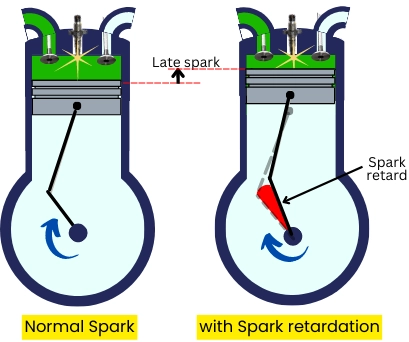
Why is Spark retardation required?
When the air-fuel mixture is rich and/or the temperature of the mixture is higher, then in such cases the time taken by the charge to generate high pressure after spark generation is less.
Thus, in this condition, if the spark plug is fired at a normal time, then the combustion of the mixture completes faster with an earlier generation of higher peak pressure, thus because of the increased peak pressure, the engine can create detonating noise.
To avoid this, the firing time of the spark plug is retarded by some crank angle. Because of late combustion, the temperature and pressure of the charge start to rise after the piston leaves the TDC.
Because of increasing volume during the expansion stroke, the peak pressure attained by the engine is lowered and the chances of knocking are avoided.
The effects of spark retardation are shown below in the crank angle vs pressure plot. The graph indicates the pressure variation at low engine speeds.
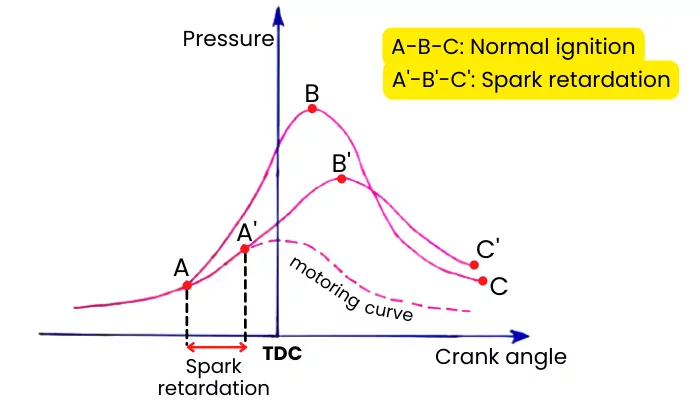
The curve A-B-C in the above figure shows the pressure rise during normal spark generation and the curve A’B’C’ shows the pressure rise during the spark retardation.
Thus due to the spark retardation, the peak pressure attained in the cylinder is lowered.
Effects of retarding ignition timing:
Because of the spark retardation, the combustion of the mixture occures late. Thus the pressure of combustion products rises after the piston starts to move away from TDC and because of increasing volume, the gases are not able to attain the peak pressure.
Therefore reduction of peak pressure decreases the chances of engine knocking.
But due to the lowering of the peak pressure, the mean effective pressure of the engine gets reduced. This results in a loss of power produced by the engine and a decrease in fuel economy.
Ignition timing too retarded symptoms:
Here are the symptoms of too retarded ignition timing.
1] Loss of Power:
If the spark firing is too retarded then the spark plug will fire very late during the compression stroke, thus the pressure of combustion products also rises lately as the piston starts moving away from TDC.
Therefore the mean effective pressure of the engine decreases that resulting in a lowering of the power output.
2] High emissions:
In some cases, the fuel does not burn completely which gives higher emissions. It also results in overheating of the engine components that can damage the exhaust valves.
3] Less fuel economy:
The specific fuel combustion of the engine increases and thus the efficiency of the engine decreases.
Advanced vs Retarded Ignition Timing:
The advancing and retarding ignition timing has the following differences:
| Sr. No. | Advanced Ignition Timing | Retarded Ignition Timing |
|---|---|---|
| 1 | Spark is generated earlier while compression stroke. | Spark is generated late during the compression stroke. |
| 2 | Ignition time advance is done to increase power at high speed. | Retarding ignition time increases power at lower speeds. |
| 3 | Ignition time advance lowers the power at lower speeds. | Retarding ignition time lowers the power at a higher speed. |
| 4 | Too advanced ignition timing can cause knocking. | Too far retarded ignition time lowers the engine power. |
FAQ’s:
-
How do I know if my ignition timing is too advanced?
The too advanced ignition timing creates a knocking or pinging sound in the engine and lowers the fuel economy.
-
What happens if ignition timing is too advanced?
Because of the too advanced ignition timing, the combustion products attain peak pressure during the compression stroke and oppose the upward movement of the piston. It causes damage of engine components.
Thank you for a clear and easily understandable explanation.
Well said. Simply and technically spot on.